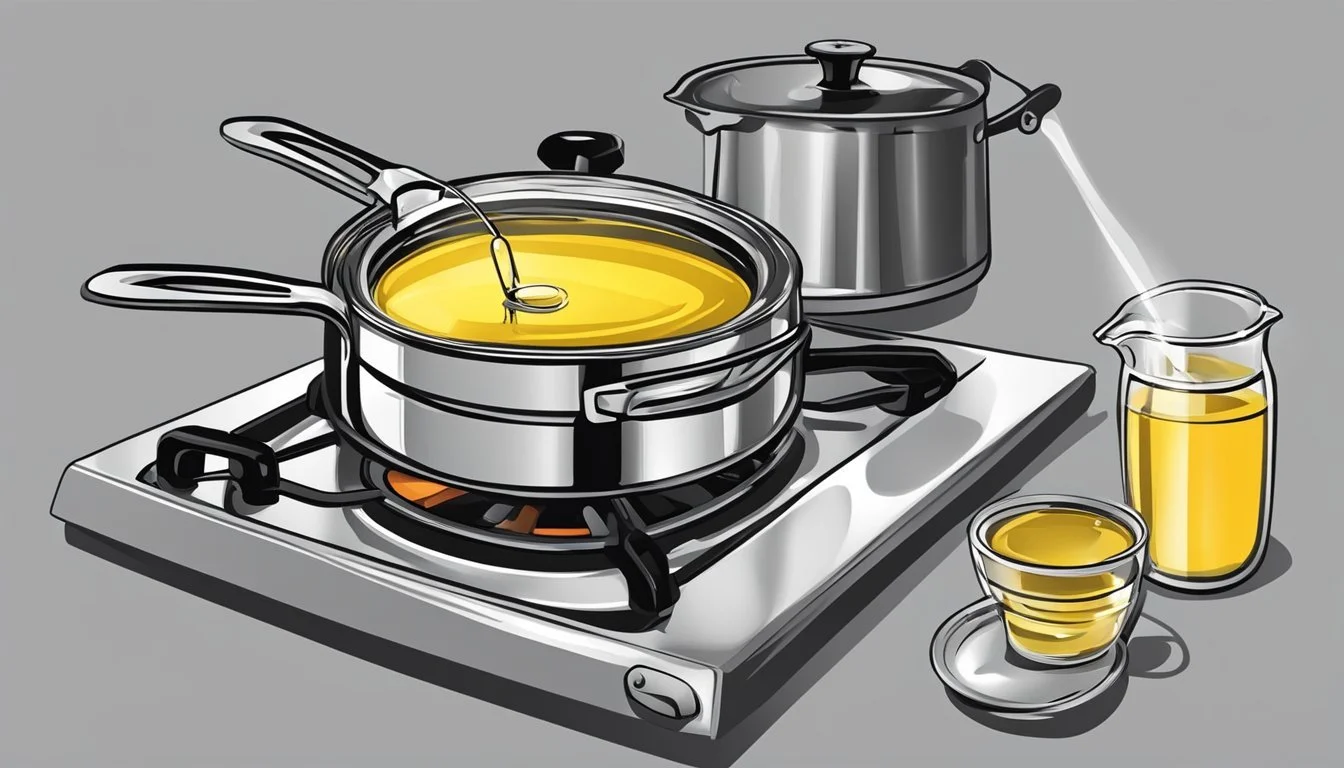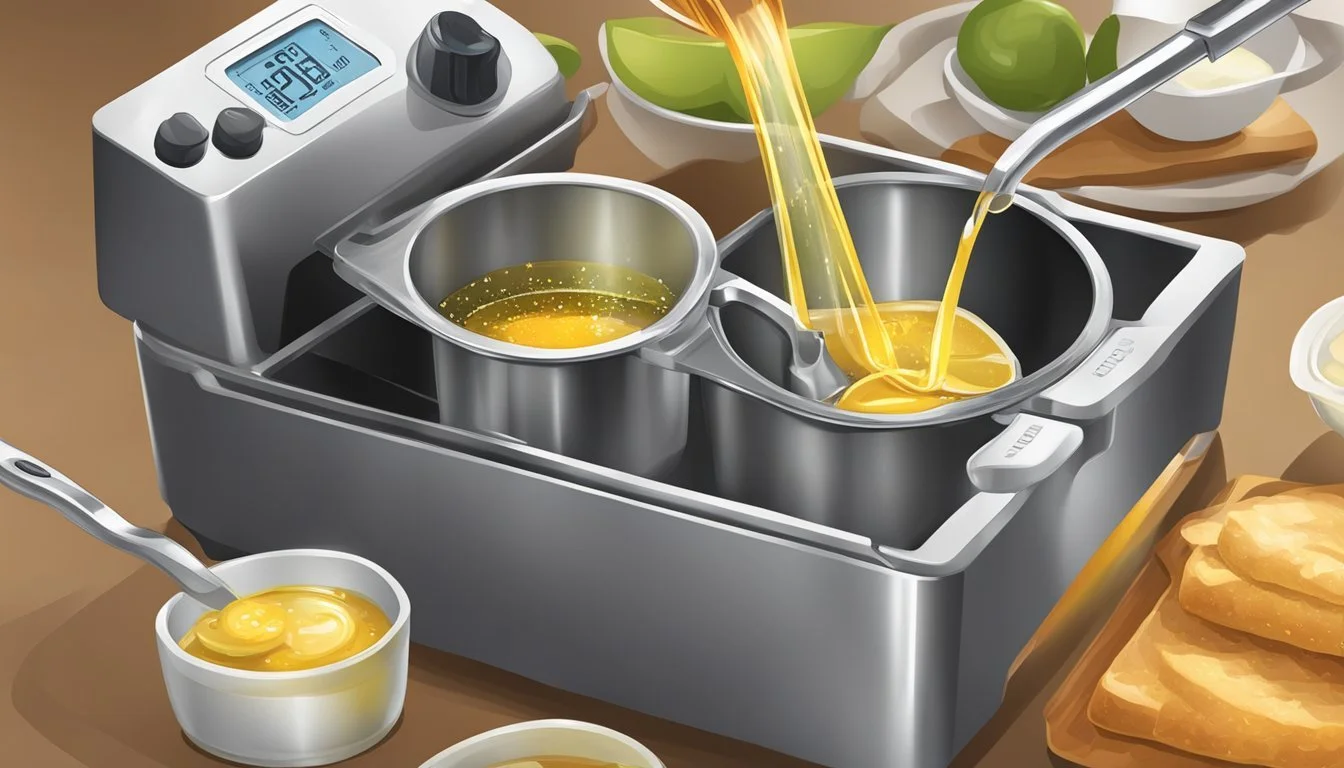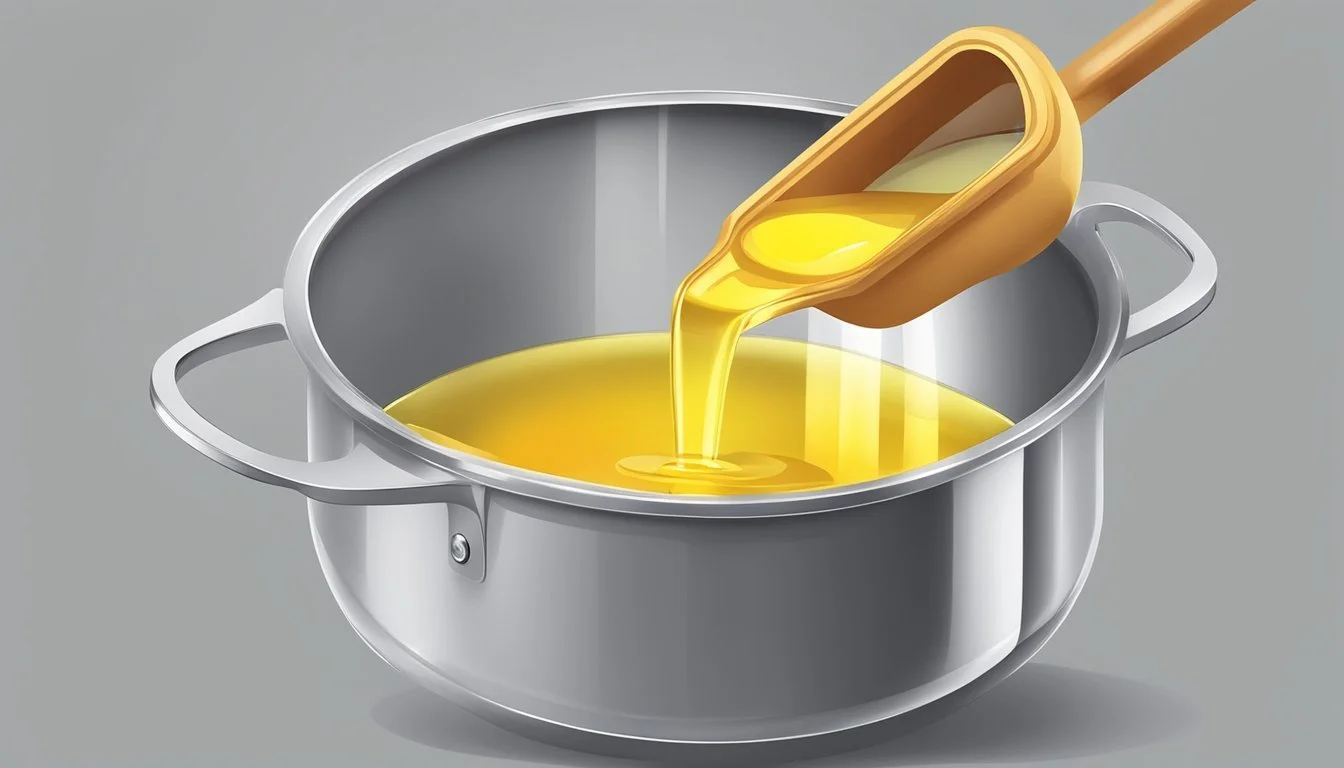How to Measure the Perfect Amount of Oil for Deep Frying
Accurate Tips for Crispy Results
Measuring the right amount of oil for deep frying is a critical step to ensure both food quality and kitchen safety. The perfect fry is often achieved by submerging food in oil that has been preheated to a temperature that seals the food's exterior quickly, creating a crispy barrier while the inside cooks evenly. The quantity of oil used affects the cooking process, as too little oil can lead to uneven cooking and oil temperature fluctuations, while too much could pose a spillover risk.
For most deep fryers, an ample depth of oil is roughly 1 inch deeper than the height of the food to be cooked. This depth allows for adequate coverage without the risk of overflow when the food is introduced. The size of the deep fryer and the type of food also influence the amount of oil required. It's essential to provide enough oil to allow food to move freely, preventing sticking and ensuring even cooking.
Calculating the precise oil level often involves placing the intended food in the fryer basket and measuring the height. Afterward, one would add an additional inch of oil to cover the food completely, keeping in mind the expansion of food and the rising of oil levels when food is added. To avoid incidents and achieve the best frying results, cooks should always be mindful of their appliance's maximum oil capacity and never exceed it.
Understanding Deep Frying
Deep frying is a culinary technique where food is submerged in hot oil until it's cooked to a golden crisp. The method hinges on the proper use of oil, including its quantity and quality, as well as maintaining the optimal temperature for cooking.
Basics of Deep Frying
In deep frying, one must ensure that the food is thoroughly submerged in oil. This necessitates the use of a significant amount of oil, often ranging from 3 inches to a point halfway up the fryer to ensure even cooking. Moreover, it's crucial that the oil is preheated to a temperature typically between 325°F (163°C) and 375°F (191°C), depending on the food being cooked.
Choosing the Right Oil
Selecting the right oil is paramount for deep frying. Oils with a high smoke point, such as peanut, canola, or vegetable oil, are preferred because they can be heated to high temperatures without smoking or breaking down. Additionally, the flavor and quality of the oil should complement the food without overpowering it.
Role of Oil in Deep Frying
Oil acts as the heat transfer medium in deep frying, cooking the food evenly and quickly. Its properties, such as smoke point, must be considered to maintain the safety and taste of the food. For instance, exceeding an oil's smoke point can impart a burnt flavor and potentially release harmful compounds. Therefore, monitoring the oil's temperature is critical in deep frying.
Preparing for Deep Frying
To achieve the best results in deep frying, careful selection of equipment and understanding of oil properties are crucial. Additionally, following safety precautions is paramount.
Selecting Your Equipment
The right deep fryer or Dutch oven can make a significant difference in frying efficiency and outcomes. For deep fryers, ensure it's equipped with a basket, a thermostat, and is of the appropriate size for your needs. The fryer should have clear minimum and maximum oil level indications. A thermometer is vital for a Dutch oven or a fryer without a built-in thermostat to monitor the temperature accurately.
Oil Smoke Point and Types
Choosing the right oil with a high smoke point is essential for successful deep frying. Oils such as peanut oil, canola oil, vegetable oil, safflower oil, and avocado oil are preferred due to their high smoke points, which range roughly between 400°F to 520°F. Olive oil and especially extra virgin olive oil have lower smoke points, making them less suitable. On the other hand, coconut oil and grapeseed oil are viable options, but they have specific taste profiles that may affect the flavor of the food.
Oil Type Smoke Point (°F) Safflower oil 450–510 Peanut oil 450 Canola oil 400 Vegetable oil 400–450 Avocado oil 520 Grapeseed oil 420 Coconut oil 350 Extra virgin olive oil 320–375
Safety Precautions
When filling the fryer, never exceed the maximum fill line, and always leave room for food displacement to prevent oil overflow. Ensure the fryer is stable on a clear, heat-resistant surface away from flammable objects. Temperature should be closely monitored—overheated oil not only spoils the taste and nutritional value but can also become a fire hazard. Keep a fire extinguisher designed for grease fires nearby and never use water to extinguish an oil fire.
Determining Oil Quantity
When deep frying, the correct quantity of oil ensures proper cooking and can affect the cost and quality of the food. The following subsections explore how to calculate the amount of oil needed and the factors that influence this quantity.
Calculating Required Oil
One must first consider the capacity of the deep fryer to ensure the appropriate volume of oil is used. It is essential to fill the fryer with oil to a level that is half to two-thirds full, but never exceeding the maximum fill line. A thermometer should be used to monitor the oil, ensuring it reaches the desired frying temperature.
For deep frying in a Dutch oven or similar cookware, they should refer to the manufacturer's guide or use the following strategy:
Place the food to be fried into the cold Dutch oven.
Pour water until the food is fully submerged by about 1 inch.
Remove the food, and mark the water level.
Drain and dry the oven, then fill with oil up to the marked level.
Sunflower oil and corn oil are common for deep frying due to their high smoke points which should typically be heated to between 325-350 degrees Fahrenheit.
Factors Affecting Oil Quantity
Various factors impact how much oil is needed:
Type of food: Foods coated with batter or breading absorb more oil than uncoated foods.
Size of the food: Larger quantities or bigger pieces of food require more oil.
Type of oil: Some oils, like sunflower oil, have a lower cost but may impart different flavors or textures compared to others like corn oil.
It's imperative that they never fill the deep fryer to the brim to allow for the displacement caused by adding food and to prevent the risk of overflows of hot oil, which can be dangerous.
Measuring Oil Temperature
Ensuring oil is at the correct temperature is critical for deep frying, as it affects both the food's quality and safety. Inaccurate temperature can lead to undercooked food or dangerously overheated oil, increasing the risk of a grease fire.
Using a Thermometer
The most reliable method for measuring oil temperature is through the use of a thermometer. There are two common types of thermometers suitable for deep frying:
Instant-Read Thermometer: Provides a quick temperature reading; ideal for checking oil temp throughout the frying process.
Candy Thermometer: Typically clips to the side of the pot, offering continuous monitoring.
Procedure:
Insert the thermometer into the oil, ensuring it does not touch the pot's bottom.
Wait for the reading to stabilize. The right temperature for frying ranges from 325 °F (163 °C) to 375 °F (191 °C), depending on the food.
Safety Note: It's essential to stay below the oil's smoke point to prevent it from starting to burn, potentially causing a grease fire.
Visual Cues for Temperature
For those without a thermometer, there are visual cues to estimate if the oil is at the right temperature:
Wooden Spoon Test: Dip the handle of a wooden spoon into the oil. If bubbles form and start floating up, the oil is hot and ready.
Popcorn Kernel: A popcorn kernel will pop at a temperature between 325 and 350 F, indicating the oil is in the frying range.
Observations:
Steady Bubbles: Signify the oil is hot enough.
Vigorous Bubbling: Suggest the oil may be too hot; it needs to cool down to prevent overheating.
No Bubbling: Indicates the oil is not yet at the desired temperature for frying.
Executing the Deep-Frying Process
Executing the perfect deep-frying process involves mastery of technique and precision in temperature control. Adequate preparation assures that the food emerges crispy and cooked to perfection.
The Frying Technique
To begin deep-frying, one must ensure that the frying oil is at the right temperature, typically between 350 and 375 °F. The cook places the food gently into the hot oil using tongs or a kitchen spider. This utensil allows for safe handling and helps prevent splashing. Food should be added to the fryer in batches to avoid overcrowding, which can lead to uneven cooking and oil temperature drops. As bubbles form, they indicate that moisture is being expelled; consistent bubbling shows proper frying, while excessive splatter may suggest too much moisture in the food.
It is crucial to have a lid on hand to cover the fryer in case of splattering, which can help contain the hot oil and prevent burn injuries. Throughout the frying process, one must use the spider or tongs to turn the food occasionally to achieve even color and doneness.
Monitoring and Adjusting Temperature
Maintaining oil at the right temperature is essential for optimal deep-frying results. The cook should use a deep-fry or candy thermometer to monitor the oil's temperature regularly. When adding food to the hot oil, the temperature will naturally dip slightly; it's imperative to adjust the heat to bring the oil back up to the desired temperature range.
If the oil temperature is too low, the food will absorb excess oil, becoming greasy. Conversely, if the oil is too hot, the outside of the food may burn before the interior is fully cooked. A stable temperature ensures that the food will fry correctly, creating steam from the moisture within the food that helps to repel oil and reduce absorption. A vigilant eye on temperature contributes to achieving that crisp exterior and fully cooked interior associated with perfect deep-frying.
Dealing with Common Deep-Frying Challenges
While deep frying can yield delicious results, it's essential to address issues like greasy food and oil splatter. Here are specific methods to cope with these challenges and assure a more enjoyable frying experience.
Preventing Greasy Food
To prevent food from becoming greasy, one must ensure the oil is at the correct temperature before adding food. Foods drop into oil that's too cold will absorb more oil and become excessively greasy. Moreover, the presence of moisture on food can cause oil to splatter and result in greasy outcomes. Patting food dry before frying minimizes moisture and reduces the chances of greasy food. Here's a technique to test oil readiness:
Wooden Spoon Test: Dip the handle of a wooden spoon into the oil. If steady bubbles form around it without being aggressive, the oil is at an ideal temperature, generally around 350°F to 375°F.
Managing Splatter and Smoke
To manage splatter, use tools that provide safety and control. Long-handled tongs or frying baskets can place food gently into the hot oil, lessening the risk of splatter. It's important to avoid overcrowding the fryer, as this drops the oil temperature and increases splatter danger.
When oils are heated beyond their smoke point, they begin to break down and smoke, which can impart a burnt taste to food and potentially cause a fire hazard. Cooking with an oil with a higher smoke point can help prevent this. Additionally:
Using a Lid: A spatter screen or lid helps contain splatter but must be used carefully to avoid trapping steam.
Monitoring: Keep a close watch while frying to quickly react and lower the heat if the oil starts to smoke, preventing burns and smoke development.
After Frying: Handling and Reusing Oil
After frying, one can maximize the life of frying oil by handling it correctly and making informed decisions about its reuse. Proper storage and assessment are crucial to maintaining the oil's quality and the flavor of subsequent fried foods.
Storing Used Oil
Once the oil has cooled to room temperature, it should be strained through a fine mesh strainer, potentially lined with cheesecloth, to remove food particles. These particles can spoil the oil and affect the flavor and crispiness of food fried in the future. The oil should be stored in a sealed container to limit exposure to oxygen, which can degrade the quality. It's ideal to keep the container in a cool, dark place, away from heat sources and direct sunlight, as heat can increase the rate at which the oil becomes rancid.
Deciding On Reusing Oil
Determining when to reuse oil involves an assessment of its color, aroma, and viscosity. The oil should be a light golden color and free of off-smells or excessive froth—indices of retained freshness and quality. Reused oil should not be overused, as it can accumulate saturated fats, monounsaturated fats, and polyunsaturated fats, leading to a degradation in taste and potential health risks. The number of reuses should be limited, and the oil should be discarded if it shows signs of excessive smoking, foaming, or a rancid smell, as these are clear indicators that the oil's quality has significantly deteriorated.
Health and Nutritional Considerations
When selecting the appropriate oil for deep frying, health and nutrition should be at the forefront. It is important to understand how different types of fats react to high temperatures and the impact this has on one's diet.
Types of Fats and Oils
Oils can be categorized based on the types of fat they contain:
Saturated fats: These fats, found in high amounts in coconut oil and beef tallow, are known for their stability at high temperatures. Their structure remains intact during deep frying, leading to minimal oxidative damage.
Monounsaturated fats: Oils rich in monounsaturated fats, like high-oleic canola and olive oil, offer a balance between stability and nutritional benefits. They are resistant to high heat, making them a healthier option for frying.
Polyunsaturated fats: Commonly found in soybean, corn, and vegetable oil, polyunsaturated fats are less stable when exposed to high temperatures. This can result in the formation of harmful compounds.
Trans fats: Industrially produced trans fats, often found in hydrogenated vegetable oils, are associated with adverse health effects and should be avoided for deep frying.
Table Summarizing the Stability of Fats at High Heat:
Type of Fat Examples of Oils Stability at High Heat Saturated Fats Coconut Oil, Beef Tallow High Monounsaturated Fats High-Oleic Canola Oil, Olive Oil Moderate to High Polyunsaturated Fats Soybean Oil, Corn Oil, Vegetable Oil Low Trans Fats Hydrogenated Vegetable Oils Very Low
Impact of High-Temperature Cooking
The process of deep frying requires temperatures typically around 350-375°F (175-190°C). At these high temperatures, oils undergo changes:
Oxidative Stability: Oils with higher oxidative stability, such as saturated and monounsaturated fats, are less prone to creating harmful oxidation products.
Formation of Harmful Compounds: When oils are pushed beyond their smoke point, they can form harmful compounds, including trans fats and substances linked to disease risk.
Therefore, it's crucial to choose oils with a high smoke point and stability to minimize health risks associated with deep frying.
Culinary Tips and Final Considerations
In deep-frying, the perfect oil amount is crucial to ensure that food reaches the ideal crispy and golden brown texture.
Enhancing Flavor and Texture
A key consideration for achieving flavorful and texturally superior deep-fried food is the oil level. One should always use enough oil to completely submerge the food items. This ensures even cooking and avoids the greasy texture that can result from under-fried food. Maintaining the oil at a consistent temperature between 325°F (163°C) and 375°F (191°C) is vital for developing a crispy exterior while keeping the inside tender.
For sweet items like funnel cakes, the oil's temperature should hover around the lower end of the spectrum to avoid burning the delicate batter.
Savory foods like potato chips or french fries excel with a slightly higher temperature, creating that crave-worthy crunch.
Frying Various Foods
Different foods require specific considerations when it comes to deep frying:
Fish and meat: Should be fried until they achieve a golden exterior while ensuring they're fully cooked inside without being dry.
Vegetables: They benefit from quick immersion to preserve their colors and nutrients, ending with a crisp texture.
French fries: Aim for a double fry technique—first at a lower temperature to cook through, then at a higher temperature for a golden and crunchy finish.
Properly deep-fried food shouldn't be greasy. If the oil is too cold, the food will absorb more oil than desired, lacking crispiness. Conversely, too hot oil can lead to an overcooked, bitter exterior and undercooked interior. A cooking thermometer is a deep-fryer's best friend, ensuring precise oil temperatures.







